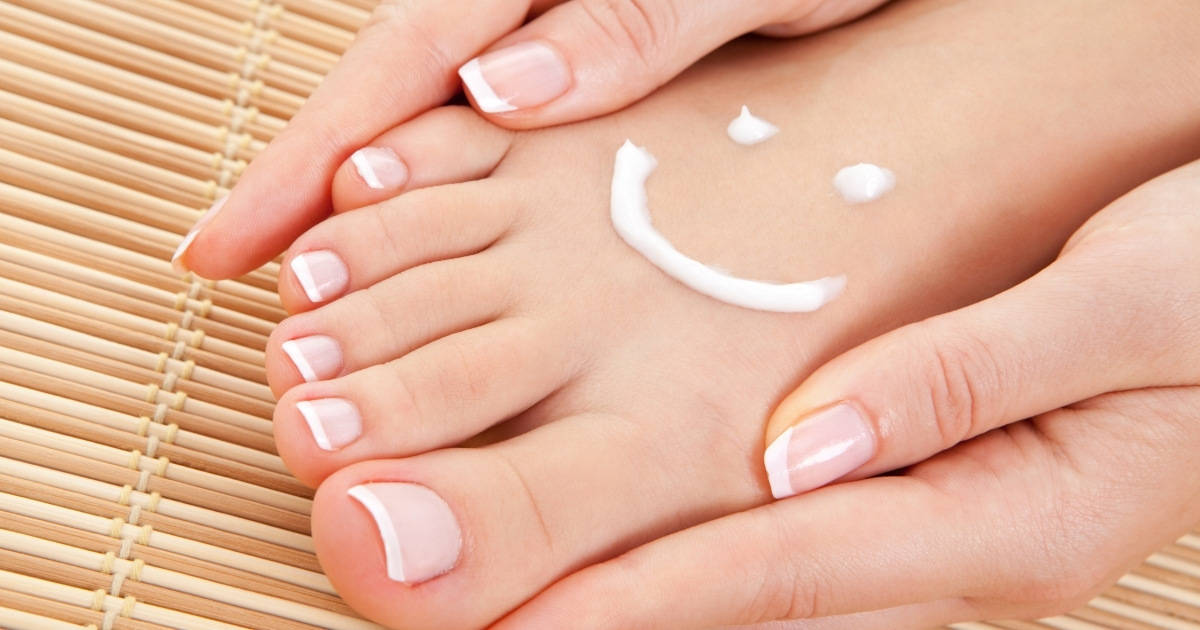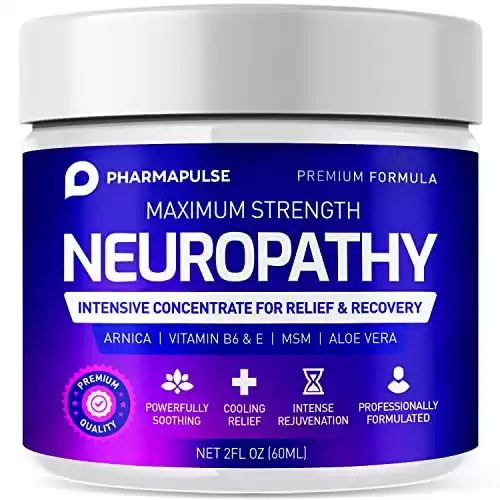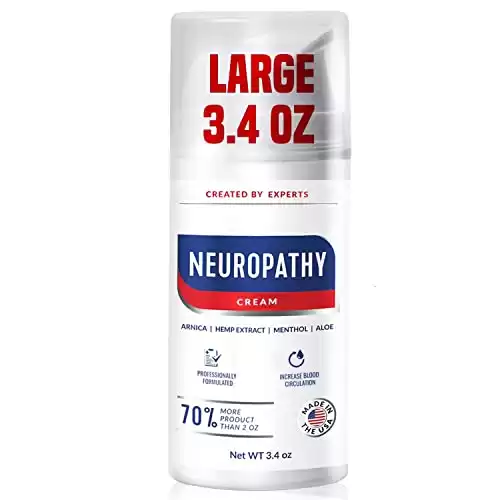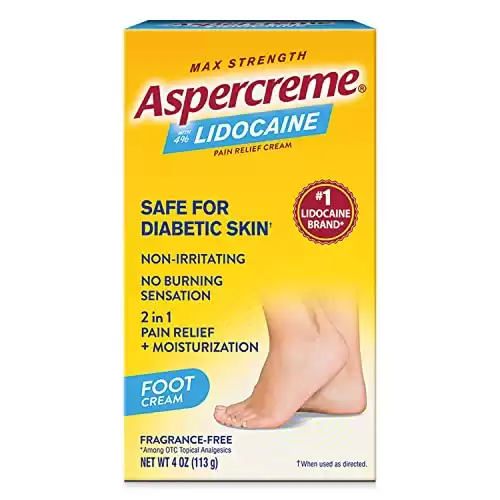This post may contain affiliate links. Please read our disclosure.
If you live with diabetic neuropathy, you may be familiar with a tingling or burning sensation within your feet.
This sensation is a common symptom of neuropathy and most people living with this pain will want relief in some form or another.

Why use a neuropathy foot cream?
Doctors often prescribe oral medication for these issues, but they can come with side effects, like dizziness, fatigue, or drowsiness.
You also won’t be sure when the medication will take effect, which can be an issue for those that want instant pain relief.
One way of resolving this problem is with topical neuropathy creams. These can be applied to the painful area, like the feet, to deliver quick and effective pain relief.
These creams are generally affordable, readily available, and painless to apply.
However, as there are so many pain relief creams available, it can be confusing to figure out which one is best for your neuropathy symptoms.
Prescription, non-prescription, herbal, or medicinal, each has its benefits and drawbacks. It’s important to know more about these creams before making any purchases.
To make it a little easier for you, we’ve listed the best creams for feet-related neuropathy in this article.
We’ve also included an in-depth buying guide with all the information you need to make a purchase.
You’ll learn more about the pain-relieving ingredients within these treatments, as well as guidance on applying the creams to your feet.
You’ll find all you need to know about diabetic neuropathy foot creams below!
The best neuropathy foot creams
The main active ingredient in this cream is capsaicin, a substance taken from chili peppers. Capsaicin reduces a pain transmitter within the nerves, preventing them from feeling pain.
The formula also contains known anti-inflammatory ingredients, including Vitamin B6 and Aloe Vera. These encourage blood flow and reduce swelling, helping to relax sore areas and relieve pain.
Along with Aloe Vera, Vitamin E and Vitamin B12 keep the skin nourished from the inside out, keeping rough, dry patches at bay.
The bottle contains thirty applications which is enough for a month. Besides the feet, the cream can be applied on any painful areas affected by neuropathy, including the back, knees, and hands, making it a versatile product.
- Lots of anti-inflammatory ingredients - Works well at relieving pain and soreness
- Many moisturizing ingredients - Soothes dry skin and keeps feet soft
- Pump applicator - Delivers cream quickly and efficiently
- Some people may not find capsaicin an effective pain reliever
- Coconut oil base absorbs slowly and may leave residue on feet
This cream is full of antiseptic and anti-inflammatory ingredients that keep the pain away.
Arnica and vitamin b6 work to soothe and relieve pain and swelling, while Aloe vera dilates the blood vessels to encourage better blood flow.
Tea tree oil is known for its antiseptic properties, which may help keep foot fungal infections at bay, an important feature for diabetics.
The cream also contains vitamin E. Along with the Aloe vera, the formula keeps the feet moisturized and free from drying out.
The formula also contains a small amount of menthol for a slight cooling sensation. This is pleasant, but it also acts as a light pain reliever.
Other than the feet, the cream can be used on any painful areas affected by neuropathy, including the hands and lower legs.
- It contains a small amount of menthol - A light cooling sensation without a potent smell
- Contains tea tree oil - A natural antiseptic ingredient known for targeting fungal infections
- Contains Arnica - Ingredient known for relieving painful swelling
- At just 2 oz, there's not a lot of cream in the jar
Conquer Pain's pain-relieving cream is ideal for those that prefer to avoid artificial products.
The formula contains six natural substances that are known for their pain-relieving properties, including Willow Bark, Eucalyptus, and Comfrey.
Arnica extract acts as a powerful anti-inflammatory ingredient, while menthol provides a cooling feeling which relieves aches and pains in the feet.
Applying the cream helps increase blood flow for a soothing sensation, which also promotes faster healing.
The formula also contains moisturizing ingredients like olive oil and glycerin. These can help to prevent dryness and rough patches on the feet.
- Lots of natural ingredients - Good for those that want to avoid synthetic substances
- Contains menthol - Provides a pleasant cooling sensation and effective pain relief
- Pump applicator - Delivers cream quickly and efficiently
- Some people may be allergic to various herbs in the formula
- It may not absorb quickly due to olive oil and glycerin
This analgesic cream from Aspercreme contains 4% Lidocaine, the largest amount available to purchase without a prescription.
Lidocaine works by preventing pain signals from reaching the brain and numbing the feet as you apply the cream.
Applied topically, the skin soaks up the cream quickly, allowing the lidocaine to target painful areas quickly. The solution will absorb quickly and won't leave any moisture behind on the skin.
The formula also contains barbadensis leaf juice, another term for Aloe Vera.
This not only moisturizes the skin but also has anti-inflammatory effects that can help soothe tired or painful feet.
This cream is fantastic at rapidly relieving minor foot pain, but it also contains seven skin moisturizers that keep the skin soft and free from cracks.
- Lidocaine cream - Effective ingredient that blocks pain signals
- Contains 4% Lidocaine - Largest amount available without prescription
- Fragrance-free - A better choice for sensitive skins
- The product is fragrance-free, but its natural odor may be off-putting for some.
Diabetic neuropathy foot cream buyers guide
Why do I get painful feet?
Our cells need glucose for energy, but too much glucose, especially for people living with diabetes, isn’t good for the body.
High glucose levels can harm the protective coating that surrounds our nerves. When this coating is damaged, this can result in pain that feels like ‘pins and needles’ around the body.
The pain can also feel sharp, like burning or stabbing.
This can occur in the hands, but it usually occurs in the lower half of the body, within the lower legs and feet.
This condition is known as diabetic peripheral neuropathy, also known as DPN.
Doctors usually prescribe oral medication to treat DPN, but topical treatments may help relieve some of the pain too. We’ll cover these treatments in more detail below.
Topical creams for neuropathic feet
Topical creams for neuropathy pain contain pain-relieving substances that are absorbed through the skin. They are applied to the skin, wherever the patient feels pain.
Before trying these creams, take note that most of these treatments still require more sound research to support their effectiveness.
Neuropathic creams generally come in two kinds: analgesic and anesthetic. These both work differently to target pain.
One works by preventing the nerves from sending pain signals, while the other numb the skin to stop the wearer from feeling pain.
What are analgesic creams?
The term ‘analgesic’ means pain relief. You don’t need to get a prescription from a medical professional to use analgesic creams.
A lot of analgesic creams contain capsaicin, a substance that is sourced from hot chili pepper seeds.
Capsaicin makes it difficult for the body’s nerve cells to deliver pain signals to the brain.
Rubbing capsaicin cream on painful body parts may relieve some of the pain.
What are anesthetic creams?
Anesthetics are medicines that prevent the user from feeling pain. Anesthetic creams help relieve pain by numbing the desired area of skin.
Most anesthetic creams contain lidocaine. As the cream sinks into the skin, lidocaine prevents the nerves in that area from delivering pain signals to the brain.
You can also find numbing patches that contain lidocaine. These have an adhesive backing so you can apply them directly onto a painful area.
While some anesthetic creams can be bought without a prescription, if the pain is particularly severe, your doctor may prescribe you prescription-level anesthetic creams, such as EMLA.
These work a lot faster than non-prescription varieties, generally within the same hour that they are applied.
Substances within topical neuropathy creams
Topical neuropathy creams can contain various substances that are known to relieve pain.
These contain various pain-relieving ingredients, such as capsaicin, lidocaine, menthol, and natural herbs.
Capsaicin
Capsaicin is found within hot chili peppers. It works by reducing a pain transmitter within the nerves known as Substance P.
Several studies have assessed whether capsaicin can help those with neuropathy.
A study in 2012 found that topical creams containing 0.075% capsaicin helped those who felt nerve pain following surgery.
The same cream also aided some people who had diabetic neuropathy. In this 2017 review, researchers looked at studies that examined capsaicin products.
Participants in the studies had various conditions where the pain was a side effect. These included HIV neuropathy, post-herpetic neuralgia, and peripheral diabetic neuropathy.
Some participants told the researchers that capsaicin creams improved the pain a lot, but some found that the cream didn’t help that much.
The findings are mixed, so while capsaicin creams may help relieve pain in some people, they may not do the same as others.
Nevertheless, we can assume that some people may benefit from trying capsaicin creams, especially if other neuropathy treatments aren’t as successful.
You can buy capsaicin creams at the drugstore, or over the counter at your local pharmacy.
Most of these will have a smaller amount of capsaicin within. Those who need stronger creams will have to contact their doctor for a prescription.
Things you should know before applying capsaicin cream
Before you begin applying capsaicin cream, consider the following advice.
Avoid using the cream near the eyes and mucous membranes. Capsaicin cream can be very irritating when it touches these areas.
Never apply the cream to cuts, broken skin, or open wounds. Store the cream out of sight and away from children and pets.
Lidocaine
Lidocaine relieves pain by preventing pain signals from reaching the brain.
Lidocaine ointments and creams are applied topically, temporarily numbing the areas you apply them on.
Lidocaine products can also be applied to other injuries, such as insect bites, general scrapes, and light burns.
A 2017 paper found that topical lidocaine medication relieved peripheral neuropathic pain in those unable to take oral medicine.
It also helped those that underwent negative reactions to other medication.
You can purchase over-the-counter lidocaine medication at your local pharmacy. Some examples include Anestacon, Lidoderm, Senatec, and LidoRx.
Some injuries may be too painful for over-the-counter creams. In this case, you may need stronger pain relief from a prescription cream that contains more lidocaine.
A doctor will be able to prescribe you these creams if deemed necessary. A popular prescription lidocaine cream is EMLA.
EMLA can numb the skin very quickly, usually within the same hour that it is applied.
Things you should know before applying lidocaine creams
Like any medication, lidocaine topical treatments may cause side effects. These include:
- Allergic reactions, eg. skin rash
- Headaches
- Difficulty breathing
- Drowsiness
- Dizziness
- Chills and/or fever
- Vomiting
- Nausea
Take care during the time after you apply lidocaine cream. Lidocaine creams will numb the area of the body you apply them on.
This increases the likelihood of you injuring the body part without realizing it.
Menthol
Menthol is a substance found within mint plants, but it can also be made synthetically in a laboratory.
Menthol is often used in mint gum and mouthwash to deliver a refreshing, cool sensation. Menthol is also used in skin creams to relieve light pain.
Several significant cancer centers recommend menthol treatments to those experiencing cancer-related neuropathy.
Menthol creams have a few advantages. They are affordable, readily available, work rapidly, and deliver effective pain relief. They are usually available to purchase over the counter at your local pharmacy.
Some examples include Bengay and Absorbine Jr. You won’t need a prescription for these.
Those who need stronger pain relief can obtain a prescription from their doctor for a more potent menthol cream.
These treatments may also contain other pain-relieving medications. For example, DicloStream is a topical treatment that contains diclofenac.
This is an NSAID, a nonsteroidal anti-inflammatory medication. DicloStream also contains menthol.
People usually use DicloStream for knee osteoarthritis pain, but studies have shown that the medication works well on neuropathic pain.
Things you should know before applying menthol creams
Take care when applying menthol creams, as products that contain a lot of menthols may cause burns.
In some cases, these can be as serious as second or third-degree burns. If your treatment contains more than 3% menthol, apply cautiously.
This is the same advice whether the menthol is the only ingredient or if it’s blended with another substance.
Remember, always notify your doctor before considering any kind of topical pain relief treatment, including menthol creams.
Herbs and natural ingredients
Topical creams can also contain natural ingredients that may relieve neuropathy pain. Several herbs are said to deliver anti-inflammatory and analgesic effects.
These ingredients work by making the brain think that the skin has become cooler, relieving inflammation, fever, and swelling.
They can also dilate blood vessels to increase blood flow to the affected area, resulting in faster healing.
Various natural plants and herbs may treat neuropathic pain by delivering other effects.
Other than anti-inflammatory effects, they may contain antioxidants that prevent cell damage, prevent cells from dying, and defend the nervous system and brain structures from harm.
More research is needed, but several studies have found that herbs and natural ingredients may relieve pain.
These include ginger, turmeric, willow bark, Boswellia, and devil’s claw.
Many herbal products are available to buy over the counter at your nearest pharmacy, though they are also found at health and grocery stores.
Some popular examples include Biofreeze, Capsin, Tiger balm, and Trixaicin.
Herbal products do come with a disadvantage, as you won’t know whether they will work for you until you try them.
Studies have looked into their effectiveness, but not at the same level as actual medicine.
Everyone is different, so your body may react differently to someone else’s on the same medication.
Things you should know before applying herbal remedies
Herbal pain remedies are readily available at pharmacies and health stores without a prescription. Even so, you should always talk to your doctor before using these products.
Herbal products may be natural, but they may still affect other medications you are already taking.
Some products may be unsafe to use if you live with other medical conditions.
Herbal remedies may also come with side effects, including allergic rashes, thinning of the blood, and effects on the heart and liver.
Guidance when applying foot neuropathy creams
Before you start applying neuropathy creams to your feet, consider the following tips.
- Never apply lotion in between the toes, as this can lead to infections later.
- Be cautious when standing after applying creams to the feet. Creams can make the feet slippery, increasing the risk of falling.
- Massaging the feet can relax the muscles and improve circulation. This can work well alongside the creams to deliver pain relief.
- As noted above, creams that contain numbing ingredients, like lidocaine, reduce sensation in the feet. You may not notice any injuries on the affected area, so take care in the period after applying the cream.
- Never wrap your feet in plastic or bandages with the cream. This can reduce circulation, which is very dangerous for people living with diabetes.
- Never place your feet in cold or very hot water. Cold water constricts the blood vessels to reduce circulation. Very hot water may burn or injure the skin on your feet, increasing the risk of infection later.
Preventing diabetes-related foot issues
Neuropathy creams can help relieve pain in your feet, but remember, prevention can help a lot more than a cure.
Diabetes-related foot issues with pain and the skin are usually linked to high blood sugar and many skin issues will disappear when Hemoglobin A1C returns to normal levels.
The DCCT (Diabetes Control and Complications Trial) also found that returning glucose levels to near normal levels reduces the chance of neuropathy by 60-69%.
Keeping a healthy lifestyle and managing your blood sugar levels can go a long way in preventing foot problems.
Here are some things you can do to keep your feet healthy.
- Keep checking your feet daily for blisters, wounds, and sores.
- Wearing comfortable shoes with good arch support can help to prevent pain.
- Wearing socks made from cotton rather than synthetic materials will help keep the feet dry and moisture-free.
- Regularly trimming your nails helps prevent ingrown nails. Creams and lotions will keep the feet moisturized, but remember to avoid applying between the toes.
- Avoid scratching at all costs.
- Always talk to your doctor about your diabetes-related skin and/or foot issues to prevent complications later.
Frequently asked questions
What’s the difference between regular skin lotion and diabetic lotion?
‘Diabetic’ creams and lotions don’t exist. There are no skincare products that are designed to cure diabetes-related skin issues.
Creams that have a ‘diabetic’ label are usually higher priced. However, there are creams that are designed to relieve neuropathy pain.
If you live with peripheral neuropathy, particularly in the feet, you can find creams that contain pain-relieving ingredients.
Why should people with diabetes not put lotion in between the toes?
People with diabetes need to take care of their feet, but they should never apply lotion between their toes. Lotion adds moisture to the skin.
Moisture can build up in the small spaces between the toes, leading to fungus and bacterial infections.
It’s ok to apply a cream to your foot skin, but make sure that the area between the toes remains dry.
How do you apply neuropathy foot cream?
All neuropathy creams will come with their application instructions. In most cases, foot creams are usually applied on dry, clean feet.
People with diabetes are recommended to carefully wash and dry their feet every day. You can apply your cream of choice after doing so.
After drying your feet, apply your neuropathy lotion, cream, or balm to the foot skin. Gently massage the feet, focusing on the painful or dry areas.
Massage can help relieve pain alongside the cream. Remember, never apply lotion in between the toes. This area needs to be dry to avoid infections.
Other products for diabetic neuropathy
You can also consider using compression socks to treat diabetic neuropathy or help reduce pain and swelling.
We have a comprehensive guide to the best socks for diabetic neuropathy that includes reviews of the top choices.
Foot massagers can also help with pain relief by improving blood flow and circulation. You can read our guide to the best foot massagers for people with diabetes to learn more.







